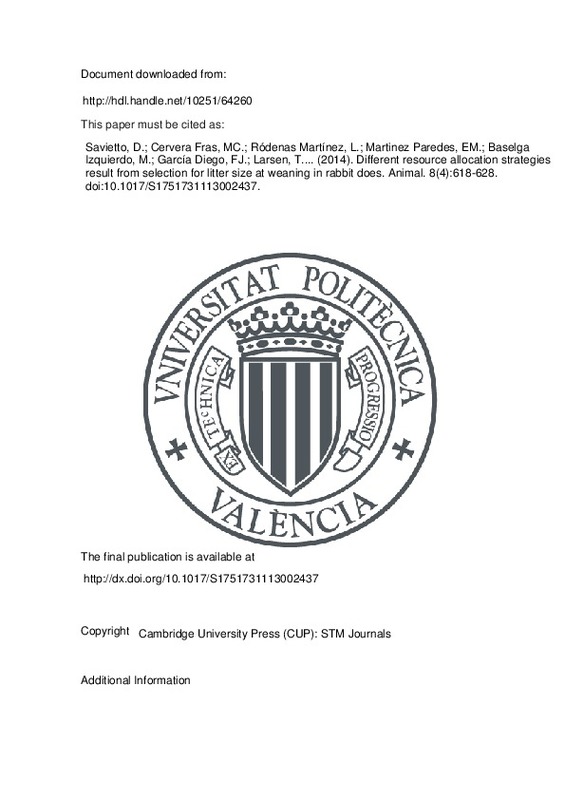García-Diego, F.-J., Pascual, J. J., & Marco, F. (2011). Technical Note: Design of a large variable temperature chamber for heat stress studies in rabbits. World Rabbit Science, 19(4). doi:10.4995/wrs.2011.938
Ragab, M., & Baselga, M. (2011). A comparison of reproductive traits of four maternal lines of rabbits selected for litter size at weaning and founded on different criteria. Livestock Science, 136(2-3), 201-206. doi:10.1016/j.livsci.2010.09.009
Friggens, N. C. (2003). Body lipid reserves and the reproductive cycle: towards a better understanding. Livestock Production Science, 83(2-3), 219-236. doi:10.1016/s0301-6226(03)00111-8
[+]
García-Diego, F.-J., Pascual, J. J., & Marco, F. (2011). Technical Note: Design of a large variable temperature chamber for heat stress studies in rabbits. World Rabbit Science, 19(4). doi:10.4995/wrs.2011.938
Ragab, M., & Baselga, M. (2011). A comparison of reproductive traits of four maternal lines of rabbits selected for litter size at weaning and founded on different criteria. Livestock Science, 136(2-3), 201-206. doi:10.1016/j.livsci.2010.09.009
Friggens, N. C. (2003). Body lipid reserves and the reproductive cycle: towards a better understanding. Livestock Production Science, 83(2-3), 219-236. doi:10.1016/s0301-6226(03)00111-8
Littell, R. C., Henry, P. R., & Ammerman, C. B. (1998). Statistical analysis of repeated measures data using SAS procedures. Journal of Animal Science, 76(4), 1216. doi:10.2527/1998.7641216x
Estany, J., Baselga, M., Blasco, A., & Camacho, J. (1989). Mixed model methodology for the estimation of genetic response to selection in litter size of rabbits. Livestock Production Science, 21(1), 67-75. doi:10.1016/0301-6226(89)90021-3
Fernández-Carmona, J., Alqedra, I., Cervera, C., Moya, J., & Pascual, J. J. (2003). Effect of lucerne-based diets on performance of reproductive rabbit does at two temperatures. Animal Science, 76(2), 283-295. doi:10.1017/s1357729800053534
Fernández-Carmona, J., Cervera, C., Sabater, C., & Blas, E. (1995). Effect of diet composition on the production of rabbit breeding does housed in a traditional building and at 30°C. Animal Feed Science and Technology, 52(3-4), 289-297. doi:10.1016/0377-8401(94)00715-l
Harano, Y., Ohtsuki, M., Ida, M., Kojima, H., Harada, M., Okanishi, T., … Shigeta, Y. (1985). Direct automated assay method for serum or urine levels of ketone bodies. Clinica Chimica Acta, 151(2), 177-183. doi:10.1016/0009-8981(85)90321-3
Dauncey, M. J. (1990). Thyroid hormones and thermogenesis. Proceedings of the Nutrition Society, 49(2), 203-215. doi:10.1079/pns19900024
Savietto, D., Blas, E., Cervera, C., Baselga, M., Friggens, N. C., Larsen, T., & Pascual, J. J. (2012). Digestive efficiency in rabbit does according to environment and genetic type. World Rabbit Science, 20(3). doi:10.4995/wrs.2012.1152
Falconer, D. S. (1990). Selection in different environments: effects on environmental sensitivity (reaction norm) and on mean performance. Genetical Research, 56(1), 57-70. doi:10.1017/s0016672300028883
Vicente, J., & García-Ximénez, F. (1993). Effects of strain and embryo transfer model (embryos from one versus two donor does/recipient) on results of cryopreservation in rabbit. Reproduction Nutrition Development, 33(1), 5-13. doi:10.1051/rnd:19930101
Quiniou, N., Renaudeau, D., Dubois, S., & Noblet, J. (2000). Influence of high ambient temperatures on food intake and feeding behaviour of multiparous lactating sows. Animal Science, 70(3), 471-479. doi:10.1017/s1357729800051821
Theilgaard, P., Sánchez, J. P., Pascual, J. J., Friggens, N. C., & Baselga, M. (2006). Effect of body fatness and selection for prolificacy on survival of rabbit does assessed using a cryopreserved control population. Livestock Science, 103(1-2), 65-73. doi:10.1016/j.livsci.2006.01.007
Brecchia, G., Bonanno, A., Galeati, G., Federici, C., Maranesi, M., Gobbetti, A., … Boiti, C. (2006). Hormonal and metabolic adaptation to fasting: Effects on the hypothalamic–pituitary–ovarian axis and reproductive performance of rabbit does. Domestic Animal Endocrinology, 31(2), 105-122. doi:10.1016/j.domaniend.2005.09.006
Piles, M., Garreau, H., Rafel, O., Larzul, C., Ramon, J., & Ducrocq, V. (2006). Survival analysis in two lines of rabbits selected for reproductive traits1. Journal of Animal Science, 84(7), 1658-1665. doi:10.2527/jas.2005-678
Sanchez, J. P., Baselga, M., & Ducrocq, V. (2006). Genetic and environmental correlations between longevity and litter size in rabbits. Journal of Animal Breeding and Genetics, 123(3), 180-185. doi:10.1111/j.1439-0388.2006.00590.x
Quevedo, F., Cervera, C., Blas, E., Baselga, M., & Pascual, J. J. (2006). Long-term effect of selection for litter size and feeding programme on the performance of reproductive rabbit does 2. Lactation and growing period. Animal Science, 82(5), 751-762. doi:10.1079/asc200688
Vicente, J. S., & García-Ximénez, F. (1996). Direct transfer of vitrified rabbit embryos. Theriogenology, 45(4), 811-815. doi:10.1016/0093-691x(96)00010-6
Coureaud, G., Fortun-Lamothe, L., Langlois, D., & Schaal, B. (2007). The reactivity of neonatal rabbits to the mammary pheromone as a probe for viability. animal, 1(7), 1026-1032. doi:10.1017/s1751731107000389
Rommers, J. M., Boiti, C., Brecchia, G., Meijerhof, R., Noordhuizen, J. P. T. M., Decuypere, E., & Kemp, B. (2004). Metabolic adaptation and hormonal regulation in young rabbit does during long-term caloric restriction and subsequent compensatory growth. Animal Science, 79(2), 255-264. doi:10.1017/s1357729800090111
Piles, M., García, M. L., Rafel, O., Ramon, J., & Baselga, M. (2006). Genetics of litter size in three maternal lines of rabbits: Repeatability versus multiple-trait models. Journal of Animal Science, 84(9), 2309-2315. doi:10.2527/jas.2005-622
Garcı́a, M. L., & Baselga, M. (2002). Estimation of genetic response to selection in litter size of rabbits using a cryopreserved control population. Livestock Production Science, 74(1), 45-53. doi:10.1016/s0301-6226(01)00280-9
Cervera, C., & Carmona, J. F. (s. f.). Nutrition and the climatic environment. Nutrition of the rabbit, 267-284. doi:10.1079/9781845936693.0267
Nicodemus, N., Redondo, R., Pérez-Alba, L., Carabaño, R., De Blas, J. C., & García, J. (2010). Effect of level of fibre and type of grinding on the performance of rabbit does and their litters during the first three lactations. Livestock Science, 129(1-3), 186-193. doi:10.1016/j.livsci.2010.01.023
Theilgaard, P., Sánchez, J., Pascual, J., Berg, P., Friggens, N. C., & Baselga, M. (2007). Late reproductive senescence in a rabbit line hyper selected for reproductive longevity, and its association with body reserves. Genetics Selection Evolution, 39(2), 207. doi:10.1186/1297-9686-39-2-207
Martínez-Paredes, E., Ródenas, L., Martínez-Vallespín, B., Cervera, C., Blas, E., Brecchia, G., … Pascual, J. J. (2012). Effects of feeding programme on the performance and energy balance of nulliparous rabbit does. animal, 6(7), 1086-1095. doi:10.1017/s1751731111002643
Baselga M 2004. Genetic improvement of meat rabbits. Programmes and diffusion. In Proceedings of 8th World Rabbit Science Congress, 5–7 September 2004, Puebla, Mexico, pp. 1–13.
[-]







![[Cerrado]](/themes/UPV/images/candado.png)


